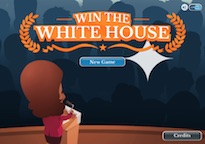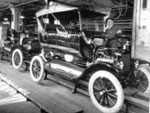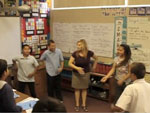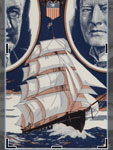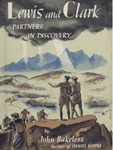These are letters that were written by Sarah Bagley Durnough. Sarah Bagley was a famous labor leader in Lowell during the 1840s. And she—as a labor leader, she at one point published the Voice of Industry, which was an important newspaper in that labor movement. She corresponded with a lot of important political figures and reformers. And this is part of her correspondence. This is one of the people she corresponded with—Angelique Martin. Angelique Martin was a Fourierist, that's a social utopian reform movement. And Angelique Martin had taken an interest in the Lowell factory women who were struggling to get a 10-hour workday in the factories.
So what I have here are three letters between Sarah and Mrs. Martin, thanking Mrs. Martin for her support at one point, and also discussing some pretty important ideas with her. I find the letters particularly important because Mrs. Martin had really encouraged these young women to start thinking about issues of women's rights. And in this letter it becomes clear, that it's from this correspondence and that encouragement that there is a definite interests in women's rights that starts to develop among these factory workers. And eventually, in Sarah's case, is leading to a critique of both the labor movement and eventually the labor newspaper that she's involved in because some of her colleagues and co-workers are not so sensitive to the issue of women's rights.
Well, first of all these letters became fascinating because they helped us to find Sarah. Like most women, once she got married she had disappeared from the historic record. And it's in this set of letters that we find out what her married name is—Dornough—and that opened up a whole new area of research for us, because once we had a married name we could start tracing her again, and we were able to do that.
But secondly the other thing I found so fascinating about these letters is that they're really extremely powerful. And it is one thing to write a book or an article where you talk about the way in which people in the labor movement may or may not have been sensitive or interested in other reform movements going on around them, whether it be anti-slavery or women's rights or whatever. It's quite another thing to actually look at the document and—particularly when the letters are very powerful—get a sense of just how important those ideas were to the person.
So I find these letters in particular to be very powerful expressions of Sarah's ideas. Although I think when I look at her life, and I think about the way in which she goes off to these factories. She uses the money to buy her parents' home. She gets involved in these labor struggles. She goes to work with reform prostitutes. She becomes a doctor. She becomes a successful snuff manufacturer. You know this is a very powerful woman, so it doesn't surprise me that her letters are so moving.
Make sure first of all, that you pretty much understand what the person is saying. And if there are things that don't quite makes sense I think, the important thing to realize is that it's probably a good thing, not a bad thing. It's an interesting—it probably means the person is saying something a little surprising and unusual, and that's usually a good thing to write about. So one of the things I always tell my students is if something doesn't make sense, they should not panic, it's not them. It may actually be that they've got a good historical problem to write about.
So, if there are things that make you uncomfortable, or surprise you, or don't make sense, those are the things to go back and focus in on. Look at them more carefully. See if there are contradictions. Maybe the person who's writing is living with contradictions that we don't necessarily live with today. Maybe they're living with contradictions that we do live with today. But to go back and look at that closely, make sure you really understand that—whether it's a critique of the anti-slavery movement or a discussion of women's rights—whatever you find.
So, in addition to just looking very closely at the textual material, when you look at these letters you want to think, what is the nature of this exchange? Are you writing home to your mom? Do you want your mom maybe not to be worried about you, cause you're off at the factory? Are you writing home because you need help? I mean that kind of personal letter is going to set up one set of conventions of the kinds of things you say. And all you have to think about is the things you say or don't say to your mom and dad today, to realize that was probably true back in the 19th century, too. So you want to ask that. Certainly, if you're writing a formal letter to someone you don't know to say, ask them to come address your organization, that letter might not contain much interesting information one way or the other. It's certainly going to be a very formal letter, and you shouldn't be surprised if some kinds of emotional expressions don't show up.
This kind of letter here is somewhere in between because Angelique Martin has clearly befriended Sarah and some of her friends. On the other hand, it's a professional relationship. Mrs. Martin is an important social reformer. She clearly is a woman of some means. She's offered to help them pay for their printing press for the Voice of Industry. They're hoping she will do that. They have an important intellectual relationship because she's been introducing them to ideas about women's rights. And they've talked pretty passionately about some of these issues.
So Sarah regards her as a friend, in a way that she probably doesn't regard her sister as a friend. But she also regards her as a kind of mentor, and as someone who has—in some ways—some power over her. She wants to impress her, but she's also going to talk about the issues that they care about together; such as women's rights. But when she talks about women's rights she's going to talk passionately about it. So I think there is a sort of a way in which you need to think about what the relationship is between these two people. And we can certainly see from the letters that there are a lot of complications in this relationship. That are going to—I don't want to say necessarily shape what gets said, but they're going to put constraints or they're going to dictate a little bit how things get said. And I think that's always an important thing to keep in mind.
I would want a student to look at these letters and try to understand all of the different concerns that Sarah—and someone like Sarah—was trying to piece together. That is, to see her as more than a one-dimensional person. We know her mostly as a labor leader, but she's clearly got a much more complicated life and a lot of other demands that were being made upon her. She's being drawn in other directions with her interest in women's rights. She has demands that are being placed upon her by her family.
And I think trying to understand those issues are important, not only for understanding an individual who is involved in the movement, but also for understanding the way in which so many of these issues do overlap and intersect. We tend to treat them separately; we tend to talk about the labor movement or the women's rights movement. Or actually in one of these other letters she brings up anti-slavery. And she brings it up in a way that I think is quite important. Some historians have alluded to this, but we don't have as many sort of direct comments on it as I would like. This is in the first letter from Jan 1, 1846. And while she mentions that she's opposed to slavery, she is completely disgusted with the abolitionists—because many of the factory owners are abolitionists, but they are not at all sympathetic to their own operatives.
I think the first question I would ask them to think about is: Well, what is she really angry about here? Is she angry at slaves? Is she really secretly a racist? Is she angry at the abolitionists? If so, why? What sort of complications are being expressed here? Particularly because she starts off the letter by mentioning that when they started their labor reform association she said, they originally met in Anti-Slavery Hall. So, these are people who could have been in some ways comfortable with the anti-slavery movement. Now maybe Anti-Slavery Hall was just a sort of general public building that people used for all sorts of things. But on the other hand, I think what I would encourage the student to think about is, what precisely is her criticism here and why is she leveling that criticism.
